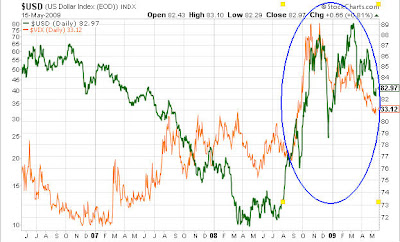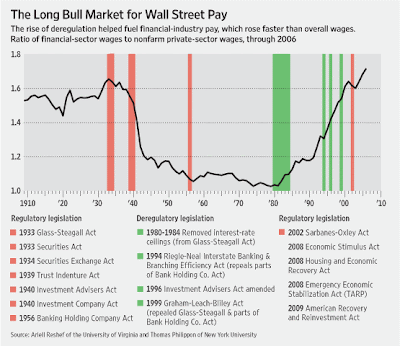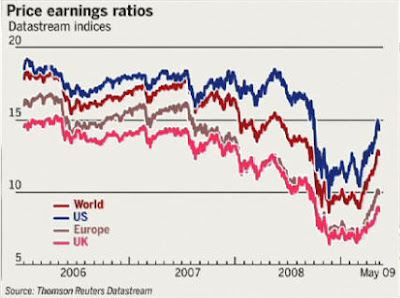Home » Uncategorized (Page 38)
Category Archives: Uncategorized
Racing to become the next Dr. Doom
Ken Rogoff and Nouriel Roubini are racing for the “Dr. Doom” title. A lot of their opinions are right to the point though.
Dollar bull vs. dollar bear
First watch this interesting debate between dollar bull and bear.
Now I will explain why I think dollar will be going down.
First I show you a graph between market volatility index (VIX) and the Dollar, in recent 3 years. The dollar shown in the graph is the dollar index, weighted by the US trade share with its major trading partners.
It’s easy to see that before August/September ’08, the two lines did not move together, and actually they often moved in the opposite direction. But right after Lehman’s fall (as circled in blue), market volatility spiked up, going all the way to above 80, and the dollar rose along with it. The reason is that risk-averse investors moved their assets and investments from overseas back to the country. With huge capital flowing back in, the dollar had a huge appreciation. Dollar benefited from risk-aversion and served a safe-haven during the time of panic.
Recently, with equity market up almost 40% and a lot of talk about “green shoots”, market confidence came back, and the volatility came down. The Dollar just broke below its 200-day moving average (see below graph for a closer relationship between the two in recent months).
My sense is that the Dollar will continue to go down. What you might see is a diverging performance: dollar going down against the commodities currencies, such as Aussie and Canadian Dollar; but going up against Euro, where the economy is weaker and the European Central Bank lags behind in economic stimulation.
In the long term, the single most important factor in determining the Dollar’s direction is the Fed’s monetary policy and US business cycle. This idea came originally from Robert Mundell, the Nobel laureate and the “father of the Euro”.
Below I show you the historical relationship between short term interest rate (in red) and the Dollar (in blue). The short term interest rate is measured by the yield of 3-month treasury bills, which closely matches the Fed funds rate.

(click to enlarge; source: St. Louis Fed)
The history goes back to 1973, where the data is last available. As you can see, the two lines roughly move in tandem with each other, with interest rate leading for the dollar for a few quarters (or even longer).
Of course, the real life is much more complicated, so is the Dollar. There are a few notable exceptions: one was after the 1973 recession, then there was 1982 recession, and lastly the most recent recession.
In the 1973 and 1982 recessions, dollar went up even when the interest went down. This was probably because the relative interest rate between the US and other developed countries was still quite large.
While the recent divergence was obviously the panic trade: the Dollar serving as safe-haven. And this is also the main reason why I predict the US dollar will go down once the economy starts to recover.
Gary Stern says recession near its end
The interview of Gary Stern, Minniapolis Fed President, on economic outlook.
Reform executive pay
In reforming executive pay, two things need to be resolved:
1. How to properly award competent CEOs while discouraging them to take too much risk that may bring down the whole system;
2. How to align short-term gain with long-term health of the firm.
Most of the current discussion simply focuses on capping executive pay without addressing the above two incentive problems.
Some interesting graphs to share:
a. The long swing of Wall Street Pay
b. A similar graph linking deregulation with pay in financial sector:

(source: see my previous post on the evolution on financial sector)
c. recent trend in Wall Street bonuses:
Finally, a historical review on the extravagant Wall Street pay.
India: When slums are better
The film Slumdog Millionaire raised interest in Indian slums.
The battle over credit card reform
From On Point with Tom Ashbrook:
The battle over credit card reform (audio 45 mins)
The next reserve currency
Nouriel Roubini, a.k.a. “Dr. Doom”, predicts that US dollar will be replaced by Chinese Yuan within a decade or even sooner, as the world reserve currency. His bold prediction is based on the observation of the history that when British pound was replaced by US Dollar as reserve currency, Britain was a debtor nation. In his view, a creditor nation is the ultimate natural candidate for reserve currency. He obviously has China in mind.
I can only say Roubini’s prediction is too bold to be validated by history. Back in 1980s, there were also frequent talks that Japanese Yen will replace the Dollar as reserve currency because Japan ran huge trade surplus with the US, just like China today. Everybody knows what really happened. Nothing happened —the US is still the most powerful economy in the world and US Dollar still remains the world reserve currency.
According to the research by Berkeley economic historian Barry Eichengreen, it took US Dollar almost half century to eventually replace British pound as reserve currency, even American economy surpassed Britain economy long before WWII: in early 1910s. The lesson is no country will give up its reserve currency status easily.
And bear in mind China is still a relatively poor country. The most optimistic case is China will surpass the US in total GDP somewhere around 2025, and it will take another 40-50 years afterwards for China to challenge the US on the next reserve currency.
some excerpts of Eichengreen’s paper:
Everyone’s favorite heir to the throne, China, will have to solve some very serious problems before its currency begins to become attractive as a repository for other countries’ foreign exchange reserves. Removing capital controls is the least of its problems, in my view. Its financial markets are not very liquid or transparent; indeed, most of the institutional infrastructure needed for Shanghai to become a true international financial center will take decades to install. The security of property rights is uncertain, and making investors feel secure will ultimately require a transition to democracy, the creation of credible political checks and balances, and the development of a creditor class with political sway. While the renminbi is everyone’s favorite candidate for the new reserve currency champion four or five decades from now, such hopes are, in my opinion, still highly premature.
I admit letting the US dominate money printing is not the best arrangement in the international monetary system. Some change may come earlier than anybody would anticipate. I certainly hope the US government does not squander the trust by the world.
Now I attach Roubini’s premature prediction (source: NYT):
THE 19th century was dominated by the British Empire, the 20th century by the United States. We may now be entering the Asian century, dominated by a rising China and its currency. While the dollar’s status as the major reserve currency will not vanish overnight, we can no longer take it for granted. Sooner than we think, the dollar may be challenged by other currencies, most likely the Chinese renminbi. This would have serious costs for America, as our ability to finance our budget and trade deficits cheaply would disappear.
Traditionally, empires that hold the global reserve currency are also net foreign creditors and net lenders. The British Empire declined — and the pound lost its status as the main global reserve currency — when Britain became a net debtor and a net borrower in World War II. Today, the United States is in a similar position. It is running huge budget and trade deficits, and is relying on the kindness of restless foreign creditors who are starting to feel uneasy about accumulating even more dollar assets. The resulting downfall of the dollar may be only a matter of time.
But what could replace it? The British pound, the Japanese yen and the Swiss franc remain minor reserve currencies, as those countries are not major powers. Gold is still a barbaric relic whose value rises only when inflation is high. The euro is hobbled by concerns about the long-term viability of the European Monetary Union. That leaves the renminbi.
China is a creditor country with large current account surpluses, a small budget deficit, much lower public debt as a share of G.D.P. than the United States, and solid growth. And it is already taking steps toward challenging the supremacy of the dollar. Beijing has called for a new international reserve currency in the form of the International Monetary Fund’s special drawing rights (a basket of dollars, euros, pounds and yen). China will soon want to see its own currency included in the basket, as well as the renminbi used as a means of payment in bilateral trade.
At the moment, though, the renminbi is far from ready to achieve reserve currency status. China would first have to ease restrictions on money entering and leaving the country, make its currency fully convertible for such transactions, continue its domestic financial reforms and make its bond markets more liquid. It would take a long time for the renminbi to become a reserve currency, but it could happen. China has already flexed its muscle by setting up currency swaps with several countries (including Argentina, Belarus and Indonesia) and by letting institutions in Hong Kong issue bonds denominated in renminbi, a first step toward creating a deep domestic and international market for its currency.
If China and other countries were to diversify their reserve holdings away from the dollar — and they eventually will — the United States would suffer. We have reaped significant financial benefits from having the dollar as the reserve currency. In particular, the strong market for the dollar allows Americans to borrow at better rates. We have thus been able to finance larger deficits for longer and at lower interest rates, as foreign demand has kept Treasury yields low. We have been able to issue debt in our own currency rather than a foreign one, thus shifting the losses of a fall in the value of the dollar to our creditors. Having commodities priced in dollars has also meant that a fall in the dollar’s value doesn’t lead to a rise in the price of imports.
Now, imagine a world in which China could borrow and lend internationally in its own currency. The renminbi, rather than the dollar, could eventually become a means of payment in trade and a unit of account in pricing imports and exports, as well as a store of value for wealth by international investors. Americans would pay the price. We would have to shell out more for imported goods, and interest rates on both private and public debt would rise. The higher private cost of borrowing could lead to weaker consumption and investment, and slower growth.
This decline of the dollar might take more than a decade, but it could happen even sooner if we do not get our financial house in order. The United States must rein in spending and borrowing, and pursue growth that is not based on asset and credit bubbles. For the last two decades America has been spending more than its income, increasing its foreign liabilities and amassing debts that have become unsustainable. A system where the dollar was the major global currency allowed us to prolong reckless borrowing.
Now that the dollar’s position is no longer so secure, we need to shift our priorities. This will entail investing in our crumbling infrastructure, alternative and renewable resources and productive human capital — rather than in unnecessary housing and toxic financial innovation. This will be the only way to slow down the decline of the dollar, and sustain our influence in global affairs.
(added on May 15, 2009): Bloomberg also reports Roubini’s worry about the Dollar.






